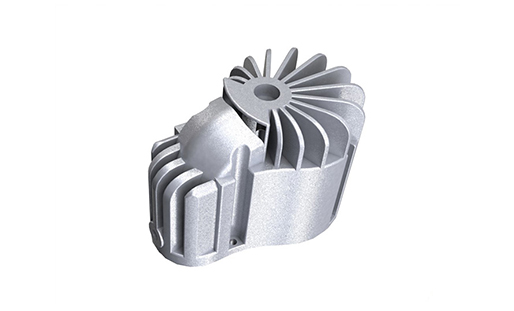At present, die-casting aluminum parts used in the industry mainly include the following series: A1-Si, Al-Mg, Al -Si-Cu. Al-Si-Mg, etc. Die-cast aluminum alloy has high specific strength, corrosion resistance, and good casting performance, processing performance, and reproducibility, as well as excellent electrical and thermal conductivity, and is widely used in the automotive, aerospace and electrical industry industries. With the development of the automobile and other industries, the output of aluminum alloy die castings increases at a rate of nearly 13% per year, and its output accounts for more than 75% of the output of all die castings. And aluminum alloy die-casting parts are developing towards high strength and high quality, which will definitely promote the further development of aluminum alloy die-casting technology.
1 Development and application of die-casting aluminum alloy
Traditional Le casting aluminum alloy parts are not suitable for heat treatment, which restricts the improvement of die-casting aluminum alloy mechanical properties. At present, die-casting aluminum alloys are widely used: they are widely used in the production of automotive structural parts, but for die-castings that require high mechanical properties, such as car bodies, it is difficult to meet the needs of existing die-casting aluminum alloys alone. In order to improve the mechanical properties of die-casting aluminum alloys and expand the scope of application of die-casting aluminum alloys, researchers at home and abroad have been developing new die-casting aluminum alloys, which mainly include two aspects: one is the optimization of alloy composition or the addition of alloying elements. Optimization of existing alloy systems; second, the development of new die-cast lead alloy systems.

Die-Casting Aluminum Motor Shell
1.1 Optimization of existing die-casting aluminum alloy series
(1) AI-Si-Cu series and Al-Si-Mg series AI-Si-Cu series alloys have good casting properties and medium mechanical properties. Typical alloys are AISi8.5Cu3.5 . and AlSil 1Cu312. Feng Junhui's use of rare earth elements to YLI12 (AISi
8.5Cu3.5) alloying, developed Al-Si-Cu-RE die-casting alloy, the alloy has good fluidity. Wear resistance, air tightness and machining performance, high-temperature performance, its mechanical properties are significantly superior to similar Aluminum. Silicon copper die-casting aluminum alloy. It can be used in automobile gearbox, die-casting aluminum motor shell, air valve, directional piston, wheel hub, high-tech electronic products, and aviation components in a high-temperature environment.
Al-Si-Mg series alloys have a high specific strength, specific modulus, heat resistance, fatigue resistance, and good physical properties. Especially A357 alloy is widely used in aviation, aerospace, and military industries.
(2) An A1-Si binary eutectic alloy
For AISil2 binary eutectic aluminum-silicon alloy, it is suitable for manufacturing complex, thin-walled parts with less strict bearing requirements, such as instrument panels, shields, shells, etc. The problem that has long plagued the alloy is its low strength and poor mechanical processing performance, which limits its use. The alloy has been used in die castings such as brackets and trays. It is an alloy that can meet the performance requirements of die casting technology and has the good cutting performance.
(3) AI-Mg series alloy
The addition of Mg to the Al-Mg series alloy exacerbates the tendency of oxidation and slag formation during smelting, and the difficulty of die casting control is greater than that of the Al-Si series alloy. It is mainly used for some die-casting parts with special appearance and anti-corrosion requirements and low mechanical properties. This alloy has excellent mechanical properties and high toughness in the die-cast state. It can be applied to structural parts and suspension system parts that cannot be heat-treated but require high mechanical properties.
1.2 Development of new die-casting aluminum alloy series
The die-casting aluminum alloys currently being developed are mainly semi-solid. Al-Si-Mg series special aluminum alloys, refractory die-casting aluminum alloys, AI-Cu series. Al-Fe series. AI-Si-Fe series high-silicon die-casting aluminum alloys. AISi6Mg2 alloy is a semi-solid special die-casting aluminum alloy developed using thermodynamic methods and the basic principles of semi-solid processing. Its comprehensive performance is better, but its plasticity is lower! In addition, the alloy needs further research on trace alloys The effect of element addition on the heat treatment of the alloy to further improve the performance of the alloy.
Aluminum-iron alloys are highly competitive high-temperature structural materials in the aerospace industry. Under ordinary casting conditions, brittle needle-like or flaky Al and Fe phases are easily formed in the aluminum-iron alloy, which severely splits the matrix, greatly reducing the mechanical properties of the aluminum-iron alloy. The solidification of aluminum-iron alloy under high pressure can reduce shrinkage and shrinkage and obtain a dense alloy structure, thereby improving performance.
Under the condition of die casting, aluminum-iron alloy has better mechanical properties. However, such alloys have a high melting point, poor fluidity, easy gettering, and hot cracking, which are not conducive to equipment maintenance and casting production, and further research is needed to realize their application. Hypereutectic high-silicon aluminum alloy is a promising lightweight, low-expansion, bulging, and highly wear-resistant material. In order to improve the heat resistance of high-silicon aluminum alloys, heat-resistant alloy elements such as human iron are usually added to the alloys, and Al-Si-Fe alloys are prepared through advanced die casting technology to improve their performance.